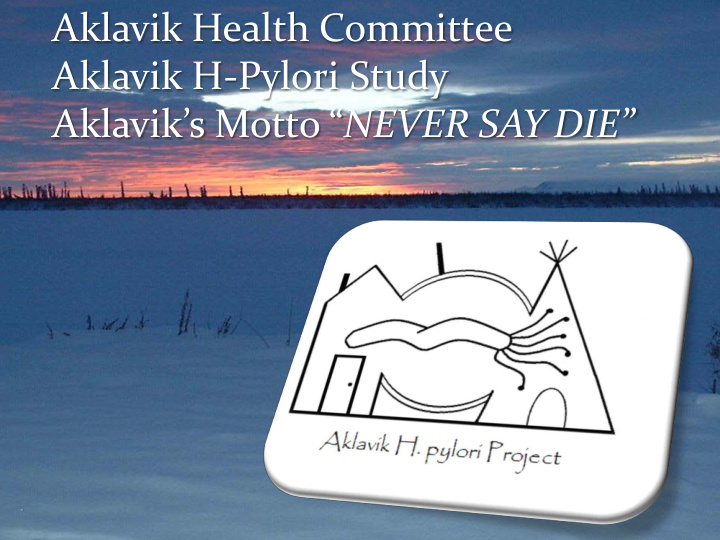



Aklavik Health Committee Aklavik H-Pylori Study Aklavik’s Motto “ NEVER SAY DIE” Aklavik H-Pylori Research and the Aklavik Health Committee
History: Aklavik will be celebrating it 100 year Anniversary in 2010
Introduction Health Committee Hamlet of Aklavik Aklavik Indian Band Aklavik Community Corporation Re-established 2004 To address health concerns To build communications between Health Centre Staff and Community
CAN Help Working Group • Ca nadian N orth Hel icobacter p ylori Working Group – Est. 2006 • 3 goals – Address community concerns – Recommend clinical management strategies – Reduce health risks
CAN Help Working Group Aklavik Community Organizations Alberta Health Services Rachel Munday Robert Bailey Nurse in Charge, Aklavik Health Centre Director, Northern Health Services Network Aklavik Health Committee Billy Archie, University of Alberta Arctic Health Research Network, Aklavik Chapter Principal Investigator: Karen Goodman Epidemiology Gastroenterology: Sander van Zanten, Justin Cheung NWT Agencies Andre Corriveau Amy Morse, Richard Fedorak Chief Medical Officer, Health and Social Services, NWT Microbiology: Monika Keelan, Joanne-Simala Grant John Morse Pathology: Safwat Girgis Medical Director, Stanton Territorial Health Authority Anthropology: Christopher Fletcher Leah Seaman Health Policy: Carl Phillips Beaufort-Delta Regional Health and Social Services Authority Susan Chatwood Director, Arctic Health Research Network
Aklavik H. pylori Project Participation • Participants recruited: 368 • Clinical surveys completed: 339 • Individuals with breath test results: 313 • Aklavik residents appearing for endoscopy: 200 • Individuals from whom biopsies were obtained: 194 • Epidemiology surveys completed to date: – Household: 94 – Individual: 167
Aklavik H. pylori Project H. pylori Prevalence • Proportion positive on breath test 58% (182/313) Disseminating updates on the number tested and community-wide prevalence during the testing period motivated others to participate
April/July 2008
Chronic Disorders Aklavik-Population 634 • Recent number from Nurse-In-Charge • these are the best figures I can come up with at the moment. • • We seem to have 90 people on our "constant monitoring" list. This is less than I previously said, because we tried very hard to take off any "young people" and educate them to be responsible for their own health care without constant reminders of need to attend for blood pressure checks etc. Some children were also taken off as they are monitored through well-child clinic. • • Of course most chronic disorder clients have more than one disorder. For example all diabetics are monitored for diabetes, heart disease, high blood pressure and high cholesterol, so the numbers below don't add up to 90 • • Diabetics 22 - adding to this list about 2-3 a year since I have been here • High blood pressure 16 (plus the 22 diabetics) • Heart disease 10 (plus the 22 diabetics) • Chest complaints 3 (but a lot more who are "self-monitoring" with chronic obstructive lung disease due to smoking) • High cholesterol 8 (plus 22 diabetics) • Cancer survivors 13 • Other conditions include osteoarthritis, thyroid disorders, rheumatoid arthritis, systemic lupus erythematosus, psoriasis, Parkinson's, seizure disorders, fetal alcohol syndrome.
Aklavik’s October 2009 Recycling depot summary • Glass 279 • Aluminum 36,229 -90% pop cans approx. • Plastic 2,885<1 litre - approx.5% water bottles • Tetra Pak and Drink Pouch 652 • Gable Top 2,062 • Bi-Metal 0 • Glass 0 • *Aluminum* 0 • Plastic 756> 1litre • Tetra Pak and Drink Pouch 106> 1 litre • Gable Top 74> 1 litre • Bi-Metal 0 • Bag-in-a-Box 0 • Glass - Refillable Bottle 0 • Glass - Non Refillable Bottle 0 • Aluminum • Other Material 0 • Glass - Other Than Wine or Spirits 0 • Other Material - Other Than Wine or Spirits • Any Material - Wine or Spirits 929 • Total units collected 43,972
Where do we go now? • Surviallience? • How do we monitor trends? • Who will lead? • How do we reduce cost for quality foods?
• Pinpoint Source-water quality • Monitor Treatment/trends • Education • Relocate water treatment plant
Future Plans Aklavik Community Economic Sustainable Development Plan Draft October 30, 2009 “Never Say Die”
Research Questions • To address project goals, the following information is needed for targeted communities: – How widespread is the infection? – What environmental factors are associated with it? – What health problems result from it? – Who requires medical care related to it? – What are the best ways to treat it? – How can it be assessed in remote communities? – How can communities be protected from it? – How can communities understand the obstacles to finding and implementing effective solutions? – How can communities recognize benefits from research on community health problems that may be difficult to solve?
Recommend
More recommend